Explore the wonders of the night sky with this chapter! Learn about stars, constellations, the Moon, and the amazing planets of our Solar System. These solutions help Class 8 students clearly understand how celestial bodies move, shine, and form part of the vast universe. Perfect for both Indian and international learners, this guide makes space science simple and interesting with step-by-step answers.
Class 8 Science Ch 17 Stars and Solar System-Textbook Solution
Choose the correct answer in Questions 1-3.
Question 1.
Which of the following is NOT a member of the solar system?
(a) An asteroid
(b) A satellite
(c) A constellation
(d) A comet
Answer:
(c) A constellation
Question 2.
Which of the following is NOT a planet of the sun?
(a) Sirius
(b) Mercury
(c) Saturn
(d) Earth
Answer:
(a) Sirius
Question 7.
In which part of the sky can you find Venus if it is visible as an evening star?
Answer:
In west side of the sky.
Question 8.
Name the largest planet of the solar system.
Answer:
Jupiter
Question 9.
What is a constellation? Name any two constellations.
Answer:
A group of stars which has a recognizable shape is called a constellation.
Example: Ursa Major, Orion
Question 10.
Draw sketches to show the relative positions of prominent stars in
(i) Ursa Major and
(ii) Orion
Answer:
(i) Ursa Major
(ii) Orion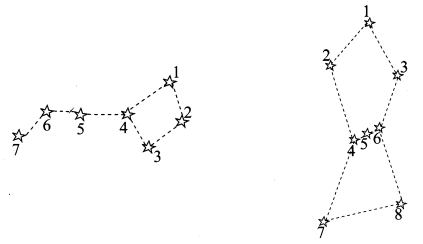
Question 11.
Name two objects other than planets which are members of the solar system.
Answer:
Comets and asteroids.
Question 12.
Explain how you can locate the Pole star with the help of Ursa Major.
Answer:
Pole star can be located with the help of two stars at the end of Ursa Major. Imagine a straight line passing through these stars. Extend the imaginary line in North direction. This line is about five times the distance between two stars. A star is seen in this direction which is called Pole star.
Question 13.
Do all the stars in the sky move? Explain.
Answer:
No, all the stars do not move in the sky. Due to the rotation of the Earth on its own axis stars seem to move in the sky.
Question 14.
Why is the distance between stars expressed in light years? What do you understand by the statement that a star is eight light years away from the Earth?
Answer:
The stars are very far away from the Earth and it is not convenient to express such distances in kilo¬metres. Thus, such large distances are expressed in unit known as light year.
If we say that a star is eight light years away from Earth, it means that the light from star will reach the Earth in eight years.
Question 15.
The radius of Jupiter is 11 times the radius of the Earth. Calculate the ratio of the volumes of Jupiter and the Earth. How many Earths can Jupiter accommodate?
Answer:
Let the radius of Earth be r units.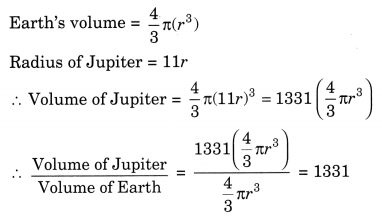
Question 1.
Mention any two differences between natural and artificial satellites. [ATS 2008]
Answer:
| Natural Satellite | Artificial Satellite |
| (i) A celestial body revolving around a planet is called a natural satellite. (ii) It cannot be used in any way. | (i) A man-made satellite revolving around the Earth is called an artificial satellite. (ii) It can be used for telecommunication and remote sensing. |
Question 2.
How is the tail of a comet formed ?
Answer:
When a comet comes near the sun, some of its ice turns into gas. Gas and loose dust, freed from ice create a long illuminating tail behind it.
Question 3.
Venus is hotter than mercury, though it is farther away from Sun. Why ? [DAV2008, 06]
Answer:
Venus contains a higher percentage of carbon dioxide. So, the greenhouse effect is more by the trapping of the infrared rays of the sun.
Question 4.
Define light year. What is the relation between light year and kilometers ? [ATS 2007]
Answer:
One light year is the distance travelled by light in one year.
1 light year = 9.46 * 1012 km.
Question 5.
Give any two points of difference between comets and meteors.
Answer:
| Comets | Meteors |
| (i) Comets are heavenly bodies which revolve around the sun in an elliptical path. (ii) Comets have a long illuminating tail. | (i) Meteors are pieces of rocks floaing in space which get heated up on entering into earth’s atmostphere. (ii) Meteors do not have a tail. |
Question 6.
Draw sketches to show the relative positions of prominent stars in
1. Ursa Major and (ii) Orion in a diagram.
Answer:
Ursa Major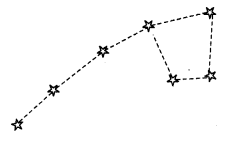
Orion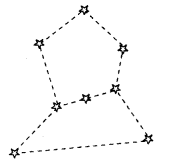
Question 7. Name a winter constellation which looks like a distorted W. Where is it visible ?
Answer: Cassiopeia is a winter constellation which looks like distorted W. It can be seen in the northern sky.
Question 8.
What is the cause of seasons on the earth ?
Answer:
The axis of rotation of the earth is not perpendicular to the plane of its orbit. This tilt causes a change in seasons.
Question 9.
Differentiate between equator plane and orbital plane of the earth.
Answer:
Equational plane is the plane of the equator. Orbital plane is the plane in which the earth revolves around the sun.
Question 10.
Name the red planet. How many moons does it have ?
Answer:
Mars is the red planet. Mars has two nloons or natural satellites.
Question 11.
Name the planet which has rings around it. Give one main characteristic of this planet.
Answer:
Saturn Has rings around it. Its main characteristic is that it is least dense among all the planets.
Question 12.
Give two main characteristics of Uranus.
Answer: Uranus rotates from east to west. Uranus has a highly tilted rotational axis.
Question 13.
Name the terrestrial planets. Why are they called by this name ?
Answer:
Mercury, Venus, Earth and Mars. They are known as terrestrial planets because their structure is rocky similar to that of the Earth.
Question 14.
Draw a labelled diagram to show the position of the Earth in its orbit when the length of the day is longest in the Northern Hemisphere.
Answer: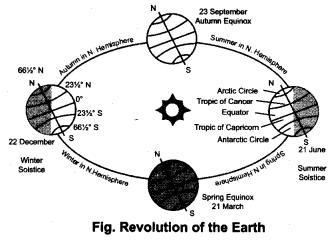
Question 15.
Name the planets that were discovered only after the invention of telescopes.
Answer:
Uranus, Neptune and Pluto.
Question 16.
What is universe ? Name two different kinds of heavenly bodies found in the universe.
Answer:
The vast unimaginable space which encompasses most distant stars, planet, etc., is called universe, Meteors and comets are the heavenly bodies in the universe.
Question 17.
Differentiate between meteors and stars.
Answer:
| Meteors | Stars |
| (i) Meteors are pieces of rocks floaing in space which get heated up on entering into earth’s atmostphere. | (i) Star is a ball of glowing gases. |
| (ii) Meteors do not have light of their own. | (ii) Stars have light of their own |
Question 18.
Give the differences between galaxy and constellation.
Answer:
Galaxy is a collection of stars consisting of millions of stars.
A constellation is a group of few stars whose arrangement can be compared to the figure of some animal or any other known material thing.
Question 19.
What is the source of energy in the Sun ?
Answer:
Nuclear fusion of hydrogen nuclei to helium takes place in the Sim.
Question 20.
What are the differences between the stars and planets.
Answer:
| Stars | Planets |
| (i) They are gaseous in nature. (ii) There are billions of stars. | (ii) They are made up of rocks and metals. (ii) There are into planets. |
Question 21.
Show the relative position of stars
(i) Cassiopiea
(ii) Leo Major
Answer: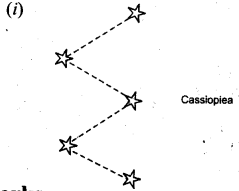
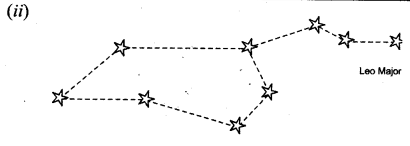
Class 8 Science Ch 17 Stars and Solar System – 3 Mark Questions and Answers
Question 1.
What is constellation ? Write two differences between a star and a constelation. [NCT 2011]
Answer:
A constellation is a group of few Stars whose arrangement can be compared to the figure of some animal or any known material thing:
| Star | Constellation |
| (i) It is a ball of glowing gases and is single. (ii) It does not remember any known figure or animal | (i) A group of stars is known as constellation. (ii) Its formation resembles sortie animal or other known figure. |
Question 2.
What is the difference between meteors and meteorites ? [MSE (Chandigarh) 2007, 2006]
Answer:
| Meteors | Meteorites |
| Meteors are pieces of rocks floating in space which get heated up on entering the earth’s atmosphere. | Meteorites are meteors which do not bum in earth’s atmosphere and reach the surface of Earth. |
Question 3. Name the: (1) star nearest to the earth. (ii) two natural satellites of Mars. (iii) minor bodies of the solar system that are sometimes able to reach the earth.
Answer:
1. Sun is the star nearest to the earth.
2. Phobos and Deimos are two natural satellites of Mars.
3. Meteorites are minor bodies that are sometimes able to reach the earth.
Question 4.
Name all the planets of the solar system in the order of their distance from Sun. [MSE (Chandigarh) 2006]
Answer:
Mercury, Venus, Earth, Mars, Jupiter, Saturn, Uranus, Neptune and Pluto.
Question 5.
What do you understand by a constellation ? Give two examples. [MSE (Chandigarh) 2005]
Answer:
Constellation are group of stars that appear to form a pattern, resembling a human figure or animal, e.g. Ursa major and Orion.
Question 6.
What is a shooting star ? Why does it bum completely before reaching the earth’s surface ?
Answer:
Shooting star are the heavenly bodies consisting of small pieces of stones and metallic rocks travelling at very high speed. They are also known as meteors.
When meteors enter the earth’s atmosphere, they get heated up due to air friction and hence bum completely.”
Question 7.
Explain the structure of the moon.
Answer:
The moon’s surface is dusty and barren and has craters of different sizes. It also has a large number of steep and high mountains.
Question 8.
Draw the diagram of Orion and explain it.
Answer:
Orion is a winter constellation having seven or eight bright stars. It is also called the hunter as the three middle stars represent the belt of the hunter. The four bright stars appear to be arranged in the form of a quadrilateral.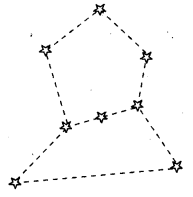
Question 9.
How can you locate the star-Sirius ?
Answer:
The star-Sirius is the brightest star in the sky and is located close to Orion. Imagine a straight line passing through the three middle stars. Look along this line towards east. This line will lead you to the Sirius.
Question 10. (i) Name the natural satellite of the Earth. (ii) In how many days this satellite completes one revolution around the Earth ? (iii) In how many days this satellite revolves around its own axis ?
Answer: (1) Moon is the natural satellite of the Earth.
2. The Moon takes 271 days to revolve around the Earth.
3. The Moon takes 271 days to spin on its own axis.
Question 11.
Name the star nearest to the Earth (except Sun).
How much time does the light from this star take to reach the Earth ?
Name the gas found in stars.
Answer:
1. Proxima Centuari is the star nearest to Earth except Sun.
2. It’s light takes 4.5 years to reach the Earth.
3. Hydrogen gas is present in the star.
Class 8 Science Ch 17 Stars and Solar System – 5 Mark Questions and Answers
Question 1.
Explain how artificial satellites help in transmission of television programmes over large areas.
Answer:
The picture and sound to be transmitted is first converted into electrical signals. These electrical signals are then converted into a special type of waves and transmitted in air from a transmitting antenna. The artificial satellites have special instruments which receive the signals transmitted by the earth stations. The signals so received are then amplified and retransmitted, by the artificial satellite that finally reach the televisions at different areas
Question 2.
Why is the distance between stars expressed in light years ? What do you understand by the statement that a star is eight light years away from the earth ? [NCERT]
Answer:
The distance between the stars is millions of kilometers, so it is not convenient to express it in kilometers. It is expressed in light years. This means that light from this star 8 years to reach the Earth.
Question 3.
The radius of Jupiter is 11 times the radius of the Earth. Calculate the ratio of the volumes of Jupiter and the Earth. How many Earths can Jupiter accomodate ? [NCERT]
Answer:
Considering the planets to be sphere.
Volume of sphere = 4πr3/3
Suppose radius of earth r
Volume of Earth = 4πr3/3
Volume of Jupiter = 4π(11r)3/3
Volume of Jupiter/Volume of Earth = 4π/3 : 1331r3
Volume of Jupiter : Volume of Earth = 1331 : 1
Question 6.
Name the Jovian Planets. Give their general characteristics.
Answer:
Jupiter, Saturn, Uranus and Neptune are known as Jovian planets. Their general characteristics are. They are mainly gaseous.. Mass and size of the outer planets are very large.. They have a ring system around them. They have a large number of moons.
Question 7.
1. Name the star nearest to the Earth.
2. Why does it appear brighter and hotter than other stars ?
3. How much time is required for light to reach the Earth from this star ?
4. Give the composition of this star.
5. What is the source of energy of this star ?
Answer:
1. Sun is the star nearest to the Earth.
2. The Sun appears brighter and hotter than other stars because it is nearest to the Earth as compared to other stars.
3. The light from the Sun reaches the Earth in 8 minutes and 20 seconds.
The Sim consists of 70% hydrogen gas, 28% helium gas and 2% of heavier elements such as carbon, nitrogen, oxygen, etc. ,
In the Sun nuclear fusion of hydrogen to helium, with the release of large amount of energy takes place.
Question 8.
Draw a labelled diagram of solar system.
Answer: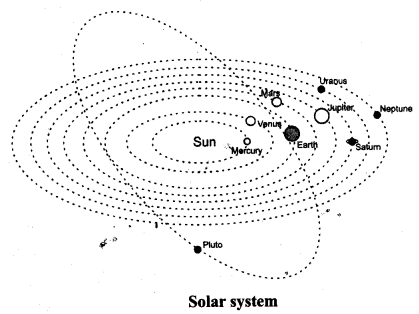
Question 9.
Compare the solar system with the structure of atom.
Answer:
| Similarities | Differences |
| (i) In an atom, the protons and neutrons are tightly packed in the nucleus and electrons revolve around it in fixed orbits. | (i) In an atom, the electrons can jump from one orbit to another. |
| (ii) In the solar system,’ the Sun is in the centre and the planets revolve around it in fixed orbits. | (ii) In the solar system, the planets remain in their orbits. They cannot change their orbits. |
Question 10.
1.What is meant by revolution of Earth ?
2.What is meant by rotation of Earth ?
3. What is the direction of rotation of Earth ?
4. How much time is required for rotation of Earth ?
5.How much time is required for one revolution of Earth ?
Answer: One complete revolution of the Earth takes 365 1/4 days. The motion of the Earth around the sun is called revolution. The spinning of the Earth about its own axis is called rotation of the Earth. The earth spins from west to east. One complete rotation of the Earth takes 24 hrs
📘 Math & Science Solutions by Class
🔹 Class 10
🔹 Class 9
🔹 Class 8
🔹 Class 7
🔹 Class 6
🔹 Class 12
🔹 Class 11
- Class 11 Math Solutions
- Class 11 Physics Solutions
- Class 11 Chemistry Solutions
- Class 11 Biology Solutions
For the official Class 10 Mathematics Solutions, you can visit:
- NCERT Textbooks (for Class 10):
